“To live in harmony with nature we will have to make lots of sacrifices.” Is this true? An emerging understanding turns this thinking on its head. The activities that people most enjoy are in fact generally low carbon and a lifestyle designed to be low carbon includes more activities such as exercise, rest, human interaction and quiet time that are now recognised to be essential to physical and mental well-being.
Since the industrial revolution energy resources have been used to fuel increased trade and commerce. The search for quality of life has been channelled into increased consumption. Only recently has it come to light that our life-supporting environment has a limited capacity to absorb the gasses emitted from the energy sources we are currently using. At the same time, new social indicators such as happiness indexing are showing that quality of life has not increased in countries with high energy use. A remarkable truth is now becoming evident: These two problems are connected. Energy use only improves quality of life up to a certain level, above which it can reduce quality of life. Most of the lifestyle choices you can make to save carbon have significant benefits for health and happiness, with the added bonus of preserving the natural environment. Not only does reducing your carbon footprint improve your quality of life, it is now possible to say that improving your quality of life reduces your carbon footprint.
Thanks to the fact that 80% of the energy we use is wasted, you can make significant cuts without giving up the things you enjoy. It is not what you do that counts, but how you do it. An approach that avoids guilt and makes you feel good is essential, as is moving forward in small, bite-sized chunks. Cutting carbon is much easier than you think, and will have a positive effect on your health, wealth and happiness.
Making the most difference
We are each involved in hundreds of activities every year. Some have large emissions and some have tiny emissions. In order to change our lifestyles we want to implement the small changes that have a big effect, and avoid the big efforts that have little effect. This way we can avoid continually feeling guilty over insignificant emissions, and relax in the knowledge that the few changes we do make are really effective. This will give you the highest feelgood factor as well as health and well-being benefits.
To make carbon reductions easy and fun, start with the easiest changes for you, and aim at an achievable target such as 4% reduction per year. Since our lives are very different, the most effective changes are completely different for different individuals. Later in this report you will have an opportunity to look at your own lifestyle, but first lets look at a typical UK lifestyle. What creates the most emissions and what are the easiest changes that make the most difference?
First, some terms:
CO2: Carbon Dioxide, the main greenhouse gas harming the environment.
CO2e: Carbon Dioxide Equivalent – a way of comparing other greenhouse gases to CO2.
Carbon: An element that, when combined with oxygen, makes carbon dioxide. However it is also commonly used as short for carbon dioxide.
Carbon footprint: The amount of CO2 emitted by one person in a year.
Tonne: 1,000 kg
Kg: 1,000 g
A typical UK citizen’s carbon footprint is 10 tonnes CO2 per year. This can be divided into five main lifestyle areas: Heating, Transport, Food, Holidays and Shopping, each emitting around 2 tonnes. Let’s look at the emissions from each of these areas in turn, and the easiest reductions.
Heating
A typical UK home spends £1,300 a year on heating. This normally emits between 4 and 8 tonnes of CO2 depending on fuel type and price. If we take an average of 6 tonnes of CO2, divided by three household occupants, this gives 2 tonnes per person.
The best way to save heating energy is to insulate your home. A typical home looses heat through the following surfaces: Lofts 10%, Windows 20%, Draughts 30%, Walls 25% and Floors 15%. Here is a table of insulation types, guide costs to install, and CO2 savings.

The low hanging fruit are loft insulation, draught proofing and double or secondary glazing. These can save energy by nearly half, cutting your footprint by 10% in one go. If you are aiming to reduce your footprint by 4% per year, this is 2½ years cuts all in one go! Once you have insulated your home and cut heatloss by half or more, you can install a properly sized, more efficient heating system to make further savings. Due to the rising price of fuel, insulation now represents one of the best investments you can make, giving a return of over 20% per year. And having a cosy home has immediate benefits for comfort and health.
Transport
Personal transportation to and from work, school, shopping and other activities (not including holidays) typically emits 2 tonnes of CO2 per person per year. For example, a 20-mile commute by car morning and evening amounts to 10,000 miles per year which in a small car emits 2 tonnes CO2. Here are some examples of CO2 emissions from different forms of transport:
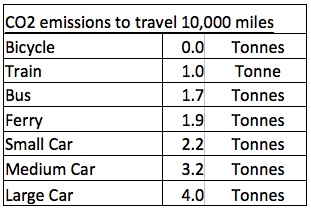
There are two ways to reduce transport emissions. One is to downshift transport type, and the other is to car share. Both these methods can save over a tonne of CO2 a year for a daily commute, a 10% reduction to your carbon footprint. Regular driving is stressful, tiring and bad for posture so taking turns to drive improves mental and physical health. Switching to bus or train allows even better rest, relaxation, social interaction or indeed work, and generally offers financial savings as well. Switching to bicycle is the best of all, with massive carbon savings and the highest benefits to health and happiness!
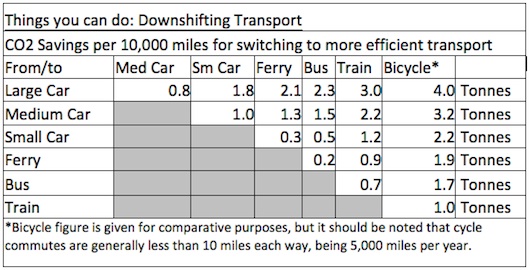
Food
Food is a complex issue, since the understanding of agricultural carbon emissions is still developing. For example, until recently it was thought that buying local is more important than buying organic. But new studies show that some food imported from Kenya has a lower carbon footprint than their equivalents grown in the UK because the emissions from intensive farming practices are greater than the transportation from Kenya. Hence you will not be able to make clear cut decisions on every item. However there are some general guidelines that work well, and using these you can reduce your food emissions by three quarters. These are:
Eat organic. Biological processes in the soil can either emit or absorb CO2. Organic practises have the lowest emissions and can even absorb CO2 from the atmosphere, storing it in the soil in the form of humus (soil carbon).
Buy from small producers. The amount of CO2 absorbed by soil depends on how much the soil is enriched. Small farms tend to increase productivity by enriching the soil with high levels of compost. This buries carbon in the soil, preventing its return to the atmosphere as CO2, and creating more fertile soil in the process.
Eat local. Local organic food has a lower footprint than imported organic food, and the same applies for non-organic.
Buy Seasonal. Non-seasonal food is preserved with packaging, processing, freezing or cold storage, or transported a long way, all of which take energy. Fresh, seasonal food has the lowest emissions, greatest health benefits and best taste!
Avoid importing water. Dried food imported by ship has a very small footprint. For example a kilo of rice feeds a family for a week, a kilo of bananas is desert for one meal, and a kilo of wine (one bottle) is simply an accompaniment to a meal. They all have the same transportation footprint. Dried grains, pulses, fruit and nuts from across the world will form part of a low carbon lifestyle for decades to come.
Avoid air freight. Transporting a kilo of food 1,000 miles by air emits 30 times more CO2 than by road, and by road emits 3 times more than by ship. Here are the figures for transporting food by different means:
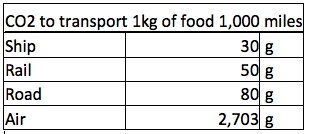
Eat happy meat. Meat is a contentious issue and the jury is still out on this subject. On the one hand chopping down rainforests to graze cattle for burgers has sky-high emissions, on the other hand permanent hilly pasture can not be used for crops and absorbs a lot of CO2. I would suggest that for the present, eating organic meat occasionally, such as lamb or other grazing animals, is probably best for your health and the environment. Hence if you like meat, a small quantity of high quality, organic, “happy meat”, is the way forward.
Eat vegan & raw. The food of the 21st Century which can now be found in a few avant garde restaurants has high levels of raw and vegan ingredients and is low in glutenGluten is a protein found in the cereals wheat, rye and barley. Obvious sources of gluten in the diet are bread, pasta, breakfast cereals and…, dairy, and artificial sugars. Being previously a great dairy lover from Devon I can’t believe I am saying this, but the best cheesecake I have ever had doesn’t have cheese in it! Blending nuts to a cream and fermenting this tastes like cheese without the usual allergenic associations. Raw and vegan is generally low carbon compared to its dairy and processed equivalents. However a diet that only includes imported foods is taking this new cuisine too far.
Finally, make room for treats! Low carbon living should improve your quality of life, and allow you to enjoy all the diversity of life on earth. Occasional treats have very little impact on your annual footprint. It is the choices you make week by week across the year that have a big effect. So at Christmas or on your birthday, enjoy mangoes, pineapples and your favourite international foods!
Holidays
Whatever you are looking for in a holiday, there is a way to do it low carbon, and it will be better as a result. The journey is an important part of the enjoyment, and low carbon transport is invariably more pleasurable and civilised. Taking extra time for the journey gives you time to prepare for new experiences so you can fully enjoy them when you arrive. And when taking into account sleep time during travel, slower journeys can actually give you more daytime holiday hours.
Usually the greatest emitter in a holiday is the travel. Three ways to cut your travel footprint are:
1. Holiday closer to home.
2. Travel by more efficient transport.
3. Reduce the frequency of long journeys.
Decide what it is you are looking for in a particular holiday. Is it rest & recuperation, special activities or cultural experience? Short holidays are most fulfilling if you have one objective. For R&R, avoiding the stress of a long journey and spending your travel money on a tailored relaxation break close to home could really hit the spot. For a special activity like skiing or surfing, look for the closest destinations that offer your sport. The Alps and South of France are only a sleeper away. If you seek a cultural or natural experience, visit the dream locations that are closest to home first – this will develop travel skills that enhance your enjoyment of exotic destinations when you travel further afield in future.
If your dream voyage is to distant lands, consider saving up holiday time and money for a six-month sabbatical. This will enable you to study the culture, learn the language, research, plan and prepare for a great journey. Look into low carbon travel modes including train, ship and crewing on yachts. (There are now thousands of yachts every year looking for crew of all ages to cross oceans). They only require eyes and ears so no experience necessary.) If you do need to fly, then make the journey count by staying a long time. A 6-week trip every three years has 1/3rd of the emissions of a two week trip every year.
Here are some figures for international transport for a return journey of 2,000 miles:
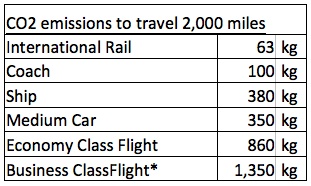
*More space, less people, more carbon per person.
How does low carbon travel compare as an experience? Here is a comparison of a journey from London to Barcelona by train and by air: By train, take the Eurostar from Kings Cross International at 3pm, cross Paris and take the train hotel at 9pm, arriving in Barcelona at 8am. The journey time is 17 hours but allowing for 8 hours sleep, gives 9 daytime hours. Booked 90 days in advance, the fare is £200 return including two nights couchette.
By Air, leave central London at 3pm and arrive Barcelona at 11pm, check into a hotel and go to sleep. The journey time from city centre to city centre including travel to airport, 3-hour check-in, average 1-hour delay and flight time, is 8 daytime hours. Booked 90 days in advance the fare is £85 return + two nights accommodation. Hence the journey time and cost is very similar for the two transport types. The train saves nearly a tonne of CO2 and having done both, my view is that the train is far more relaxing and enjoyable.
More and more people are now discovering the pleasures of low-carbon travel. Since crewing on yachts across the Atlantic myself, three friends have crewed across the Pacific and Atlantic oceans at less than the cost of a flight with no previous experience. Another friend recently cycled from London to Beijing via Iran and Turkmenistan, saying that Iran was the most hospitable country he has ever visited. Two more friends, a retired couple, recently travelled from the UK to SE Asia and back by train, bus and ferry, reporting that the most stressful part of the journey was the flight they took from India to Singapore. If you wish to test the waters, design just one of your holidays to be low carbon. When you get home, give it a mark out of ten for overall enjoyment. Do the same for a high-carbon holiday. I believe you will find that low carbon holidays deliver a greater experience.
This technique of grading experiences out of 10 is very useful for monitoring which lifestyle choices deliver the highest levels of joy and satisfaction. Modern life is full of unpleasant short-cuts to more pleasant places. But how much time do we actually spend on unpleasant short-cuts. 100% quality of life is when every moment of every day is enjoyable, healthy and preserves future enjoyable moments. In a 100% quality lifestyle there is no room for unpleasant shortcuts. Every moment of the journey and the destination is enjoyable. In a low carbon lifestyle, the journey may be slower, but every moment is more enjoyable.
Shopping
It may appear difficult to influence the emissions from manufacturing the goods you buy, from clothes to computers, washing machines to garden tools, when they are made in factories far away beyond your control. But there is something very powerful you can do: Purchase high quality, long lasting products. Manufacturing quality products produces little more CO2 than manufacturing their cheap counterparts. But if they last five times as long, they have one fifth of the footprint. (You would have to buy 5 cheap items to last the same time.) And quality products often last even longer than that.
It is said that only the rich can afford to buy cost-saving goods. But you can take the approach of making do until you can afford a quality item. I myself used hand carpentry tools until doing a big enough job to pay for a Metabo power tool. I made toast in the grill until I could afford a Dualit Toaster (hand made in England!). Paying twice the price usually buys a product that lasts five times as long. In contrast, a low-price tool I purchased recently broke within 6 weeks. What counts is CO2 emissions per year, so a product that lasts longer has lower emissions.
Here are some figures for embodied CO2 (CO2 emissions emitted in the manufacture of a product) for various household appliances:
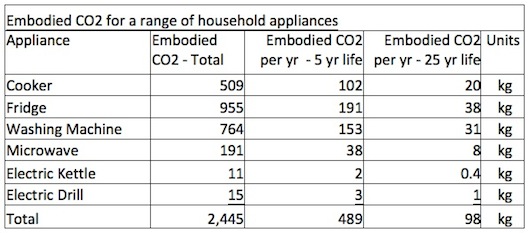
If your carbon footprint is currently 10 tonnes, and you are aiming for 4% reductions per year, your ‘carbon budget’ for next year is 9.6 tonnes. As you can see from the table above, it is much easier to budget for the long life set of appliances who’s combined emissions are under 100kg per year, than the short-life products who’s combined emissions are nearly 500kg per year. The long-lasting, high-quality products are nicer to use and also leave you more carbon to spend elsewhere, on more enjoyable pursuits!
Carbon budgeting is one of the keys to making low carbon living fun. What you save in one place you can spend elsewhere, and still reach your overall target. Being on target gives you the peace of mind that you are taking part in the international effort to preserve the environment for future generations. If your target is achievable you may exceed it, giving you an added feel-good factor. And we need all the feelgood factor we can get out of this, since carbon budgeting is a reasonably dry subject! Having said that, after 15 years of developing and living a low carbon lifestyle I can say that it makes you incredibly happy for two reasons. The happiness generated by having a clear conscience is profound and highly underestimated. But the real surprise is that the knock on effects of all those low carbon activities with extra exercise, slower pace, reduced stress, increased social interaction and more quiet time has an immensely positive effect on your physical and mental heath, wealth and happiness.
Work out your Footprint
The easiest way to enjoy cutting carbon without feeling guilty about every carbon emitting activity is to start by calculating your own carbon footprint. Doing this calculation gives you an instant handle on the subject, because you understand your own life so well. And seeing where the emissions derive from shows you what are the easiest changes for you, according to your particular lifestyle. For some people it is insulating their home, for others changing the commute and for yet others making new holiday choices. Everybody has an easy place to start – just take it one step at a time. You won’t get to the difficult areas for years and by then things may have changed, making them easier. You can split a big log by taking slices off the side, and that’s all you need to do, 4% per year.
Make a simple plan so that you don’t have to think about it all the time. And you can still enjoy one-off events such as driving to the theatre, in the knowledge that you can absorb this across your year. A very important aspect of the approach is to cut dull emissions like a driving commute and keep the fun emissions like going out for the evening. If the carbon is improving your quality of life, at least it is productive! Once you have calculated your footprint, whatever it is – don’t feel guilty! Society has been encouraging you to develop high carbon lifestyles for the last half century, so it would be unfair to give yourself a hard time if you have succeeded! Rejoice in the knowledge that if you have a high carbon footprint today, then cutting it by 4% per year will be easier, and of more benefit to the environment.
Here is a simple footprint calculator. Have a piece of paper, pencil and pocket calculator to hand to tot up some items. You can probably fill most of it in from memory, but you will need to have a rough idea of your fuel bills and car mileage. I am sorry about the trouble if you need to look these up, but calculators that don’t ask for them can be three times out. And at this time of rapid price rises, it can be beneficial to know your fuel expenditure so I hope looking them up is useful in more ways than one.
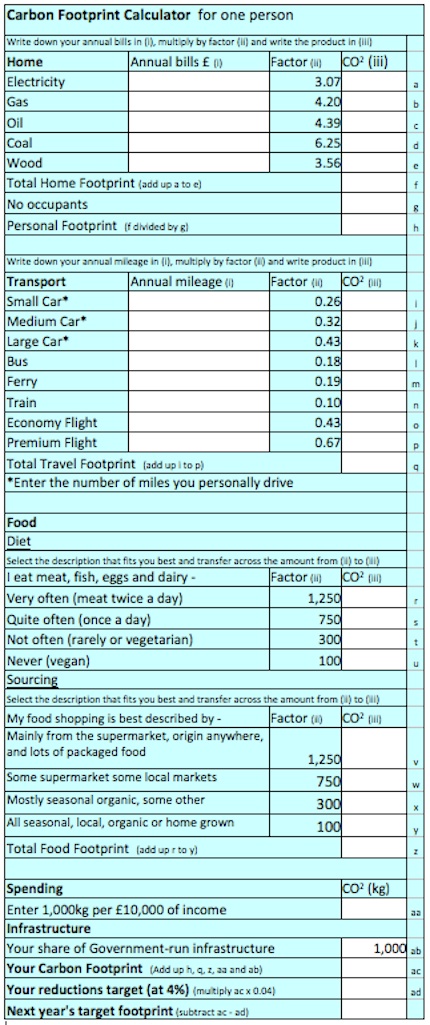
To find out more download Mukti Mitchell’s excellent ‘ Guide to Low Carbon’ lifestyles (see below).
REFERENCES
DEFRA, DECC, The Resurgence Carbon Calculator
Further work by Mukti Mitchell
The Guide to Low Carbon Lifestyles at http://www.lowcarbonlifestyle.org.uk/the-lcl-guide.html
The Resurgence Carbon Calculator at http://www.resurgence.org/carboncalculator
The OAG Holiday Carbon Calculator at http://www.outdooradventureguide.co.uk/carboncalculator.html
The CFF Agricultural Carbon Calculator at http://www.cffcarboncalculator.org.uk
Mukti Mitchell is Director of CosyHome Company and http://www.lowcarbonlifestyle.org.uk.

Comments
Join the Conversation on our Facebook Page